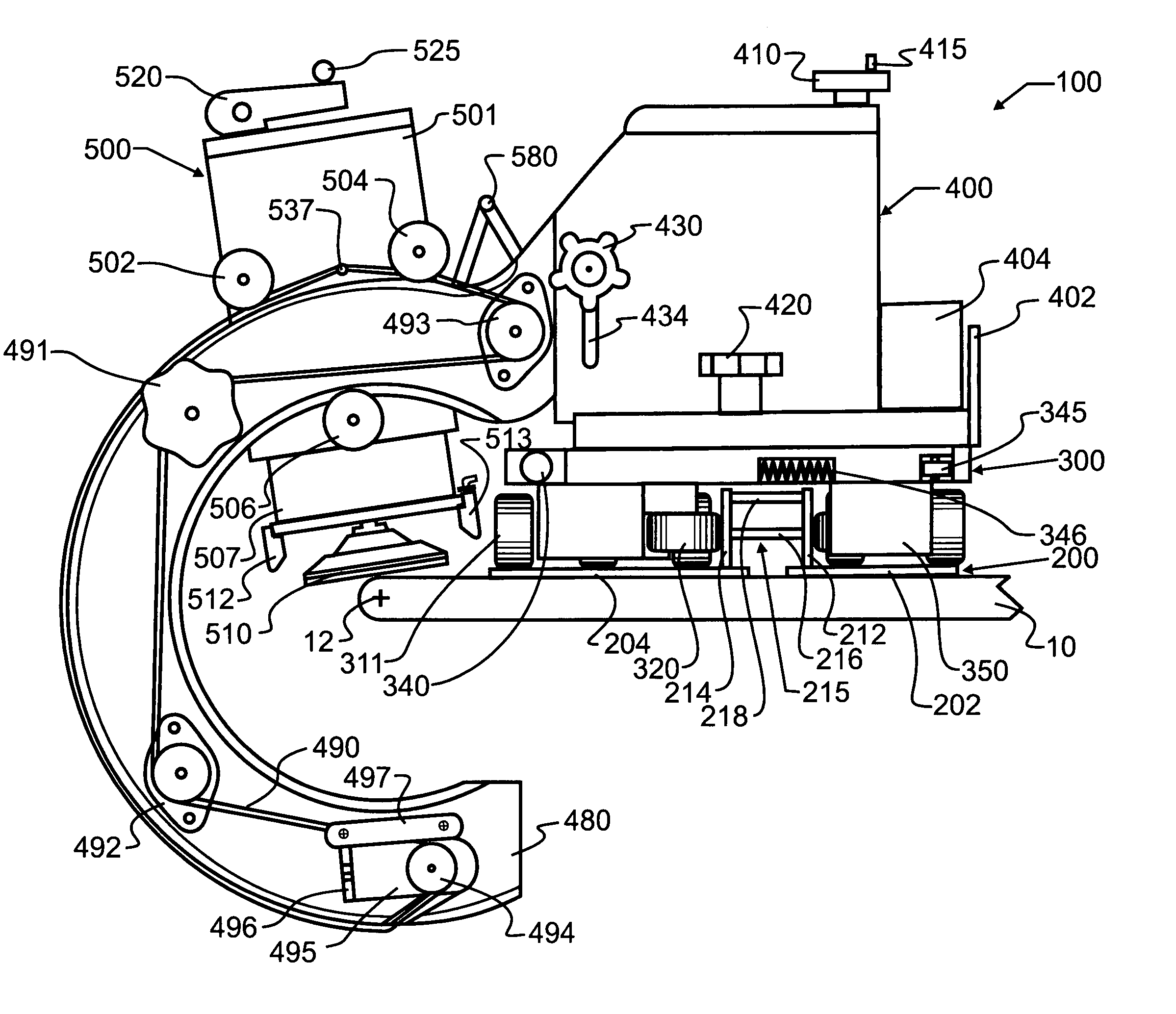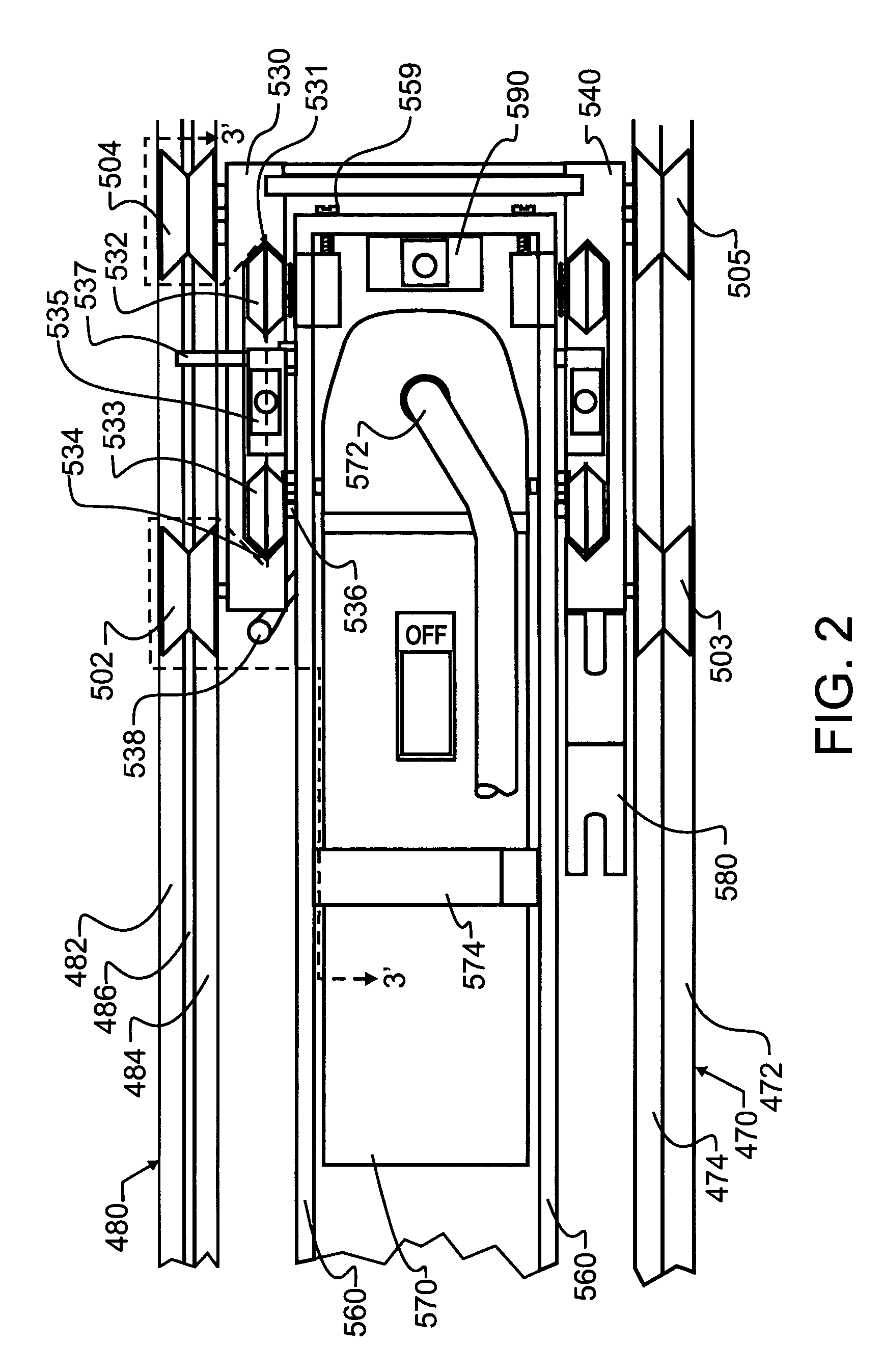Portable apparatus for working, shaping and polishing stone and other hard materials
a technology for working tools and other hard materials, applied in the field of stoneworking, can solve the problems of inconvenient use of stone for work in situ at a construction location or the like, undetectable large amounts of very expensive idle time, and reduce hand labor. , the effect of improving the precision of cutting and polishing operations
- Summary
- Abstract
- Description
- Claims
- Application Information
AI Technical Summary
Benefits of technology
Problems solved by technology
Method used
Image
Examples
embodiment 100
[0036]Trolley 300 acts as a support for a tool carrier 400 which is secured thereto. Tool carrier 400 as presently illustrated comprises a pair of crescents 470, 480 which are most preferred for the flat abrasive discs used in the preferred embodiment 100. However, those skilled in the field will recognize that the preferred embodiment trolley 300 is compatible with other structures which are known to mate with circular saws carrying diamond or other abrasive wheels, routers, and other stoneworking tools. Between crescents 470, 480 is mounted tool support carriage 500.
[0037]As illustrated in FIG. 1, crescents 470, 480 combine to form a central axis of rotation 12. Axis 12 will extend parallel to rail 215 and will be centered at the focal point of crescents 470, 480. However, once again those skilled in the field will recognize that it is not essential to form crescents 470, 480 into a circular geometry as illustrated, though this geometry is typically the most versatile. Other shape...
first embodiment
[0073]To address this need for both flexibility and rigidity, a first embodiment stiffener 800 is illustrated in FIG. 15. As may be seen therein, track 201 has a profile with two t-slots 203, 205 that run parallel to its length. The front slot 205 that is closest to crescents 470, 480 is underneath the trolley 300 center of balance. In this front slot 205 the operator will slide stiffener 800, to hold track 201 to stone or other work piece 10. After clamp 802 is secured, by placing bolts 804 and tightening screw 806 in the preferred embodiment, there is a bracket-like member 808 that pivots about hinge 807 relative to tightening screw 806. By rotating thumbscrew 809, bracket 808 will push away from clamp 802, thereby creating additional support for the end of track 201. Most preferably, thumbscrew 809 will be rotated sufficiently to make the ends of track 201 beyond work piece 10 rigid enough to support the weight of trolley 300, while track 201 remains relatively more flexible in t...
second embodiment
[0077]A second embodiment stiffener 810 is shown in FIG. 17. As illustrated therein, a specially shaped body member 818 is slid into either groove 203, 205 or both, and screw 806 tightened. The force of screw 806, owing to the intrinsic geometry of member 818, will cause member 818 to apply an upward deflection force to track 201.
[0078]As illustrated and described herein above with reference to the preferred embodiments, the present invention provides a means to shape and polish a perfect edge. The preferred embodiment is, lightweight enough for one person to carry, can be used in the field, and utilizes inexpensive abrasives. The method of shaping and polishing is safer than in the prior art, since the operator's hands are farther away from the cutter. The operator's hands are also available to control the various hoses, cords and valves. Since the weight of the apparatus is bearing on the stone slab, the physical nature of manual shaping and polishing has been made less strenuous....
PUM
| Property | Measurement | Unit |
|---|---|---|
| driving force | aaaaa | aaaaa |
| mass | aaaaa | aaaaa |
| height | aaaaa | aaaaa |
Abstract
Description
Claims
Application Information
 Login to View More
Login to View More - R&D
- Intellectual Property
- Life Sciences
- Materials
- Tech Scout
- Unparalleled Data Quality
- Higher Quality Content
- 60% Fewer Hallucinations
Browse by: Latest US Patents, China's latest patents, Technical Efficacy Thesaurus, Application Domain, Technology Topic, Popular Technical Reports.
© 2025 PatSnap. All rights reserved.Legal|Privacy policy|Modern Slavery Act Transparency Statement|Sitemap|About US| Contact US: help@patsnap.com



